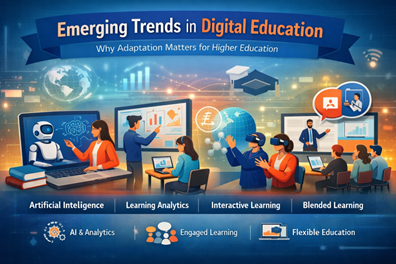By Shimna Shakeeb
The last two decades have seen rapid growth of technology integration in education. Therefore, it is not surprising to see technology integrated models such as blended, hybrid, hyflex or online models of delivery gaining momentum and becoming prevalent in the Maldives and across the world. It is predicted that in the future too, technology will have a large impact on instructional functions of the universities. According to the predictions made by the New Horizon Report (2021) published by the New Media Consortium and EDUCAUSE, the following are the key emerging technologies and practices that will have a significant impact on the future of postsecondary teaching and learning: (1) Artificial Intelligence (AI), (2) Blended and hybrid course models, (3) Learning Analytics (LA), (4) Microcrediantialling, (5) Open educational resource and (6) Quality online Learning. In recent times the popularity of blended courses seems to be growing in the Maldives, evidenced by the increasing number of students enrolled in blended programs. This new learning context with the large student numbers, the increasing use of the internet and mobile technologies and integrated learning Managements (LMS) such as Moodle and Canvas, presents an ideal environment for the effective use of LA application as they already have an existing substantial amount of data available for analysis. LA is yet to be explored in the Maldives as a solution for student learning improvement and no published knowledge of LA application at any higher education institution is available yet. Therefore, the focus of this article is to bring the readers’ attention to the 3rd aspect, learning analytics (LA) reported by New Horizon (2021) as the next big trend in higher education. The primary purpose of this article is to briefly examine the evolving world of data and learning analytics in higher education. Specifically, it will provide basic definitions, consider possible applications, identify possible benefits and impacts and finally make a few crucial recommendations required to prepare for this emerging force.
Defining Learning Analytics (LA)
Learning Analytics (LA) is a new and rapidly developing field in higher education and it began to emerge as a discipline in its own right at around 2010 (Ferguson, 2012). LA is considered as a subset of the larger field of data analytics and has emerged from the growing body of teaching and learning related data now available within higher education institutions as a result of technology integrated education delivery (EDUCAUSE, 2021). Literature offers a variety of definitions of LA. The following are a few of the definitions offered by some prominent people in the field. Cammpbell and Oblinger (2007) defined LA as the process of collecting, evaluating, analysing, and reporting organizational data for decision making. Similarly, the Society for Learning Analytics Research (SOLAR) defined LA as “the measurement, collection, analysis and reporting of data about learners and their contexts, for purposes of understanding and optimizing learning and the environments in which it occurs” (SOLAR, p.1). Likewise, Sclater, Peasgood and Mullan (2016) defined LA as the measurement, collection, analysis and reporting of data about the progress of learners and the contexts in which learning takes place. Picciano (2012), proposed LA as the science of examining data to make conclusions and, when applied in decision making, to propose paths or courses of action. What is integral in these definitions is the development of reliable and timely information resources to collect, sort and analyze the data used in the decision-making process related to teaching and learning. In defining analytics, it is critical to use data to determine the action paths, especially where there is a high volume of transactions. The primary goal of analyzing the interrelated data is to make better, evidence-based decisions about how to best support an increasingly diverse student population in higher education settings. Although, learning analytics is still at an infancy stage of development, there is convincing evidence from early adopters to support the argument that LA application can help improve student learning outcomes. (Sclater et.al, 2016)
Application of learning analytics; impacts and benefits
A white paper published by IBM (2001) entitled Analytics for Achievement described the following eight categories of instructional applications : (1) monitoring individual student performance, (2) disaggregating student performance by selected characteristics such as major, year of study, ethnicity, etc…, (3) Identifying outliers for early intervention, (4) predicting potential so that all students achieve optimally, (5) Preventing attrition from a course or program, (6) identifying and developing effective instructional techniques, (7) analyzing standard assessment techniques and instruments (i.e. departmental and licensing exams) and (8) Testing and evaluation of curricula. From these applications, monitoring individual student performance and participation in a course is among the most popular type of learning analytics applications (Picciano, 2012). An extensive review report developed by Sclater, Peasgood and Mullan, (2016) based on the emerging uses and impacts of learning analytics in the United States, Australia and the United Kingdom reported the following as the emerging uses of LA: (1) improving the quality of teaching, (2) boosting retention, (3) enabling the students to take control of their own learning. They further highlighted that LA can also be used as: (4) a tool for quality assurance and quality improvement (5) a tool for assessing and acting upon differential outcomes among the student population and (6) an enabler for the development and introduction of adaptive learning. Wong (2017), performed an extensive literature review on research conducted on the application of LA and identified the following benefits of LA applications for institutions, staff and students: (1) improving student retentions, (2) supporting informed decision making, (3) increasing cost effectiveness (4), understanding students learning behaviours, (5) providing personalized assistance for students and (6) Timely feedback and intervention. Relevant case studies have shown positive outcomes of LA applications. Considering this, it is important that higher education institutions in the Maldives also explore LA application in the blended courses to further enhance the quality of student support and improve outcomes.
Preparing for learning analytics application.
While big data and analytics is not the remedy for addressing all of the possible challenges and decisions faced by higher education administrators trying to offer quality technology integrated learning, they can become a big part of the solutions integrated into instructional functions. As the landscape of technology in education expands in the Maldives, it is important to build institutional capacity in the area of Learning Analytics (LA). According to Picciano, (2012) the first step should be to establish effective data governance structures to help with the challenges of more complex data infrastructure needs. It is also critical to have a ‘data strategy’ such as the one proposed by Stony Brook University (2017). It is only with an effective ‘data strategy’ that institutions can bring all the stakeholders together around a common set of data purposes and a mission. The ultimate goal should be to drive ‘data innovation’ in which the users of data can interpret it and take evidence-based positive action, leading to more institutional agility, optimization, and data-informed practices (Picciano, 2012). The Learning Analytics Strategy Toolkit from Tyton Partners provides strategies for implementation and self-assessment of learning analytics, with equity as a central guiding principle. The decond step proposed is to train individuals to use big data and analytics appropriately. LA necessitates institutions to house experienced database administrators and designers capable of warehousing and integrating data across multiple files and formats. Third, in addition to the expertise needed to develop databases, instructional designers (IDs) also have to be trained in these areas. IDs working with faculty in designing blended courses will need to understand and derive insights into the student behaviors that are relevant to the application at hand. Finally, institutional researchers or others knowledgeable about statistics, decision trees, and strategy mapping to develop algorithms to construct predictive models should work with the data to generate evidence to make effective decisions related to student learning interventions and support. University administrators may have to invest in consultants or undertake extensive professional development with their own staff in order to develop appropriate LA applications. Finally, and perhaps the most serious concern, is that since LA requires massive amounts of data collected on students and integrated with a variety of other databases, Universities need to be careful about privacy, data profiling, and the rights of students in terms of recording their individual behaviors (Picciano, 2012). A data protection policy is a must if LA is applied for learning improvement.
To conclude, LA has the potential to transform the way impact and outcomes are measured in learning environments – enabling providers to develop new ways of achieving excellence in teaching and learning, and providing students with new information to make the best choices about their education. Maldives, where technology integration and data management is yet to be regulated, should build the capacity of higher education systems in the area of LA application to improve student educational outcomes. It is important to note that LA is still at a relatively early stage of development across the world, but the processes for developing its use, and ensuring the authenticity and validity of the findings are developing rapidly. There is convincing evidence that learning analytics can help to develop more student-centred provision of higher education, and provide data and tools that institutions will be able to use for continuous improvement. It is believed that continued investment in learning analytics in the higher education sector will lead to better outcomes for students, universities and the wider society.
Sources
EDUCAUSE Horizon Report, 2021, Teaching and Learning Edition (Boulder, CO: EDUCAUSE, 2021).
Ferguson, R. (2012). Learning analytics: drivers, developments and challenges. International Journal of Technology Enhanced Learning, 4(5-6), 304-317.
Picciano, A. G. (2012). The evolution of big data and learning analytics in American higher education. Journal of asynchronous learning networks, 16(3), 9-20.
Sclater, N., Peasgood, A., & Mullan, J. (2016). Learning analytics in higher education. London: Jisc. Accessed February, 8(2017), 176.
Siemens, G. (2013). Learning analytics: The emergence of a discipline. American Behavioral Scientist, 57(10), 1380-1400.
Wong, B. T. M. (2017). Learning analytics in higher education: an analysis of case studies. Asian Association of Open Universities Journal.




